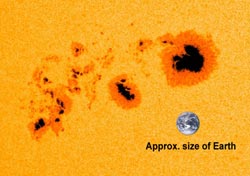NASA's SDO Sees Giant January Sunspots

One of the largest sunspots in the last nine years, labeled AR1944, was seen in early January 2014, as captured by NASA's Solar Dynamics Observatory. An image of Earth has been added for scale. Image Credit: NASA/SDO<br>
The sunspot steadily moved toward the right, along with the rotation of the sun, and now sits almost dead center, as seen in the image above from NASA's Solar Dynamics Observatory.
Sunspots are dark areas on the sun's surface that contain complex arrangements of strong magnetic fields that are constantly shifting. The largest dark spot in this configuration is approximately two Earths wide, and the entire sunspot group is some seven Earths across.
For comparison, another giant sunspot, five to six Earths across, is shown below from 2005. The image was captured by the European Space Agency and NASA's Solar and Heliospheric Observatory.
Sunspots are part of what's known as active regions, which also include regions of the sun's atmosphere, the corona, hovering above the sunspots. Active regions can be the source of some of the sun's great explosions: solar flares that send out giant bursts of light and radiation due to the release of magnetic energy, or coronal mass ejections that send huge clouds of solar material out into space.
As the sunspot group continues its journey across the face of the sun, scientists will watch how it changes and evolves to learn more about how these convoluted magnetic fields can cause space weather events that can affect space-borne systems and technological infrastructure on Earth.
For more information on sunspots and space weather, visit:
http://www.nasa.gov/mission_pages/sunearth/spaceweather/index.html
Karen C. Fox
NASA's Goddard Space Flight Center, Greenbelt, Md.
Media Contact
All latest news from the category: Physics and Astronomy
This area deals with the fundamental laws and building blocks of nature and how they interact, the properties and the behavior of matter, and research into space and time and their structures.
innovations-report provides in-depth reports and articles on subjects such as astrophysics, laser technologies, nuclear, quantum, particle and solid-state physics, nanotechnologies, planetary research and findings (Mars, Venus) and developments related to the Hubble Telescope.
Newest articles

Microscopic basis of a new form of quantum magnetism
Not all magnets are the same. When we think of magnetism, we often think of magnets that stick to a refrigerator’s door. For these types of magnets, the electronic interactions…

An epigenome editing toolkit to dissect the mechanisms of gene regulation
A study from the Hackett group at EMBL Rome led to the development of a powerful epigenetic editing technology, which unlocks the ability to precisely program chromatin modifications. Understanding how…

NASA selects UF mission to better track the Earth’s water and ice
NASA has selected a team of University of Florida aerospace engineers to pursue a groundbreaking $12 million mission aimed at improving the way we track changes in Earth’s structures, such…





















